Two sources of endogenous hydrogen peroxide in Escherichia coli
- PMID: 20149100
- PMCID: PMC3049997
- DOI: 10.1111/j.1365-2958.2010.07059.x
Two sources of endogenous hydrogen peroxide in Escherichia coli
Abstract
Mechanisms of hydrogen peroxide generation in Escherichia coli were investigated using a strain lacking scavenging enzymes. Surprisingly, the deletion of many abundant flavoenzymes that are known to autoxidize in vitro did not substantially lessen overall H(2)O(2) formation. However, H(2)O(2) production diminished by 25-30% when NadB turnover was eliminated. The flavin-dependent desaturating dehydrogenase, NadB uses fumarate as an electron acceptor in anaerobic cells. Experiments showed that aerobic NadB turnover depends upon its oxidation by molecular oxygen, with H(2)O(2) as a product. This reaction appears to be mechanistically adventitious. In contrast, most desaturating dehydrogenases are associated with the respiratory chain and deliver electrons to fumarate anaerobically or oxygen aerobically without the formation of toxic by-products. Presumably, NadB can persist as an H(2)O(2)-generating enzyme because its flux is limited. The anaerobic respiratory enzyme fumarate reductase uses a flavoprotein subunit that is homologous to NadB and accordingly forms substantial H(2)O(2) upon aeration. This tendency is substantially suppressed by cytochrome oxidase. Thus cytochrome d oxidase, which is prevalent among anaerobes, may diminish intracellular H(2)O(2) formation by the anaerobic respiratory chain, whenever these organisms encounter oxygen. These two examples reveal biochemical and physiological arrangements through which evolution has minimized the rate of intracellular oxidant formation.
Figures
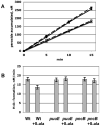

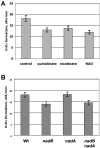
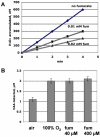
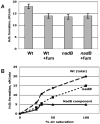

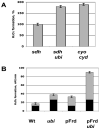


Similar articles
-
Oxygen as Acceptor.EcoSal Plus. 2015;6(2):10.1128/ecosalplus.ESP-0012-2015. doi: 10.1128/ecosalplus.ESP-0012-2015. EcoSal Plus. 2015. PMID: 26734697 Free PMC article. Review.
-
Mechanism of superoxide and hydrogen peroxide formation by fumarate reductase, succinate dehydrogenase, and aspartate oxidase.J Biol Chem. 2002 Nov 8;277(45):42563-71. doi: 10.1074/jbc.M204958200. Epub 2002 Aug 27. J Biol Chem. 2002. PMID: 12200425
-
Preparations of Terminal Oxidase Cytochrome bd-II Isolated from Escherichia coli Reveal Significant Hydrogen Peroxide Scavenging Activity.Biochemistry (Mosc). 2022 Aug;87(8):720-730. doi: 10.1134/S0006297922080041. Biochemistry (Mosc). 2022. PMID: 36171653
-
The identification of primary sites of superoxide and hydrogen peroxide formation in the aerobic respiratory chain and sulfite reductase complex of Escherichia coli.J Biol Chem. 1999 Apr 9;274(15):10119-28. doi: 10.1074/jbc.274.15.10119. J Biol Chem. 1999. PMID: 10187794
-
[Cytochrome bd as Antioxidant Redox Enzyme].Mol Biol (Mosk). 2023 Nov-Dec;57(6):1084. Mol Biol (Mosk). 2023. PMID: 38062962 Review. Russian.
Cited by
-
Life in hot acid: a genome-based reassessment of the archaeal order Sulfolobales.Environ Microbiol. 2021 Jul;23(7):3568-3584. doi: 10.1111/1462-2920.15189. Epub 2020 Sep 7. Environ Microbiol. 2021. PMID: 32776389 Free PMC article.
-
Why do bacteria use so many enzymes to scavenge hydrogen peroxide?Arch Biochem Biophys. 2012 Sep 15;525(2):145-60. doi: 10.1016/j.abb.2012.04.014. Epub 2012 May 16. Arch Biochem Biophys. 2012. PMID: 22609271 Free PMC article. Review.
-
How Escherichia coli tolerates profuse hydrogen peroxide formation by a catabolic pathway.J Bacteriol. 2013 Oct;195(20):4569-79. doi: 10.1128/JB.00737-13. Epub 2013 Aug 2. J Bacteriol. 2013. PMID: 23913322 Free PMC article.
-
H(2)O(2) production in species of the Lactobacillus acidophilus group: a central role for a novel NADH-dependent flavin reductase.Appl Environ Microbiol. 2014 Apr;80(7):2229-39. doi: 10.1128/AEM.04272-13. Epub 2014 Jan 31. Appl Environ Microbiol. 2014. PMID: 24487531 Free PMC article.
-
Antioxidant Defense by Thioredoxin Can Occur Independently of Canonical Thiol-Disulfide Oxidoreductase Enzymatic Activity.Cell Rep. 2016 Mar 29;14(12):2901-11. doi: 10.1016/j.celrep.2016.02.066. Epub 2016 Mar 17. Cell Rep. 2016. PMID: 26997275 Free PMC article.
References
-
- Blaut M, Whittaker K, Valdovinos A, Ackrell BAC, Gunsalus RP, Cecchini G. Fumarate reductase mutants of Escherichia coli that lack covalently bound flavin. J Biol Chem. 1989;264:13599–13604. - PubMed
-
- Bolivar F, Rodriguez RL, Green PJ, Betlach MC, Heyneker HL, Boyer HW, Crosa JH, Falkow S. Construction and characterization of new cloning vehicles. I. Ampicillin-resistant derivatives of plasmid pMB9. Gene. 1977;2:95–113. - PubMed
-
- Bunch PK, Mat-Jan F, Lee N, Clark DP. The ldhA gene encoding fermentative lactate dehydrogenase of Escherichia coli. Microbiology. 1997;143:187–195. - PubMed
-
- D’mello R, Hill S, Poole RK. The cytochrome bd quinol oxidase in Escherichia coli has an extremely high oxygen affinity and two oxygen-binding haems: implications for regulation of activity in vivo by oxygen inhibition. Microbiology. 1996;142:755–763. - PubMed
Publication types
MeSH terms
Substances
Grants and funding
LinkOut - more resources
Full Text Sources
Other Literature Sources
Molecular Biology Databases

